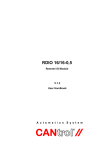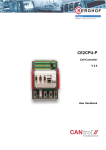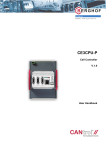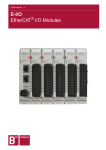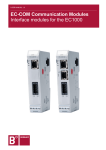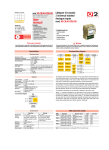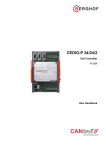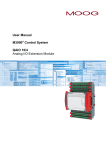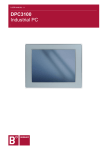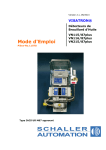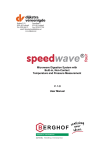Download User Manual M3000® Control System RDIO 16/16-0,5
Transcript
User Manual M3000® Control System RDIO 16/16-0,5 Remote Module with Digital I/Os and and CANopen Interface NOTES ON THIS MANUAL This M3000® module is commercialized by Moog and Berghof Automationstechnik together. RDIO The main part of this manual was created by Berghof Automationstechnik GmbH and was inserted unchanged. Therefore, it is possible that some terms in this manual do not correspond to the terms used in the other M3000® manuals. COPYRIGHT © 2003 Moog GmbH Hanns-Klemm-Straße 28 71034 Böblingen (Germany) Telefon: +49 7031 622-0 Telefax: +49 7031 622-100 E-Mail: [email protected] [email protected] Internet: http://www.moog.de http://www.moog.com/M3000 All Rights Reserved. No part of this manual may be reproduced in any form (print, photocopies, microfilm, or by any other means) or edited, duplicated, or distributed with electronic systems without prior written consent from Moog. Offenders will be held liable for the payment of damages. RESERVATION OF CHANGES AND VALIDITY Subject to changes without prior notice. The information included in this manual is valid at the release date of this manual. See footer for version number and release date of this manual. EXCLUSION OF LIABILITY This manual was prepared with great care and the contents reflect the authors’ best knowledge. However, the possibility of error remains and improvements are possible. Please feel free to submit any comments regarding errors or incomplete information to Moog. Moog does not offer any guarantee that the contents conform to applicable legal regulations, nor does Moog accept any liability for incorrect or incomplete information and the consequences thereof. TRADEMARKS Moog and Moog Authentic Repair are registered trademarks of Moog Inc. and its subsidiaries. DIN EN ISO 9001 Our quality standard is according to DIN EN ISO 9001. A Moog • User Manual RDIO • (Version 1.0; 09/03) All product designations mentioned in this manual are trademarks of the respective manufacturers. The absence of the trademark symbols ® or ™ does not indicate that the name is free from trademark protection. RDIO 16/16-0,5 Remote I/O Module V.1.2 User Handbook Copyright © BERGHOF Automationstechnik GmbH Reproduction and duplication of this document and utilisation and communication of its content is prohibited, unless with our express permission. All rights reserved. Damages will be payable in case of infringement. Disclaimer The content of this publication was checked for compliance with the hardware and software described. However, discrepancies may arise, therefore no liability is assumed regarding complete compliance. The information in this document will be checked regularly and all necessary corrections will be included in subsequent editions. Suggestions for improvements are always welcome. Subject to technical changes. Trademark CANtrol® // is a registered trademark of BERGHOF Automationstechnik GmbH General Information on this Manual Content: This manual describes the RDIO 16/16-0,5 CANtrol module and its modifications. The product-related information contained herein was up to date at the time of publication of this manual. Completeness: This manual is complete only in conjunction with the user manual entitled ‘Introduction to CANtrol Automation System’ and the product-related hardware or software user manuals required for the particular application. Standards: The CANtrol automation system, its components and its use are based on International Standard IEC 61131 Parts 1 to 4 (EN 61131 Parts 1 to 3 and Supplementary Sheet 1). Supplementary Sheet 1 of EN 61131 (IEC 61131-4) entitled ‘User Guidelines’ is of particular importance for the user. Order numbers: Please see the relevant product overview in the ‘Introduction to CANtrol Automation System’ manual for a list of available products and their order numbers. Ident. No.: 2800820 You can reach us at our headquarters at: Germany: Austria: BERGHOF Automationstechnik GmbH Harretstr. 1 D-72800 Eningen Phone: +49 (0) 71 21 / 8 94-0 Telefax: +49 (0) 71 21 / 89 41 00 http://www.berghof-automation.de e-mail: [email protected] BERGHOF Elektronik und Umwelttechnik GmbH Nfg KG A-6200 Wiesing 323 Phone: +43 (0) 52 44 / 6 48 08 -0 Telefax: +43 (0) 52 44 / 6 48 08 -81 http://www.berghof.co.at e-mail: [email protected] BERGHOF Automationstechnik GmbH works in accordance with DIN EN ISO 9001 BERGHOF Automationstechnik RDIO 16/16-0,5 Update Version 1.0 Date 09.99 Subject First version 02.08.00 IEC 1131 changed by IEC 61131, Export hint removed, Block diagram corrected, Text completed in Schematic Diagram of Input/Output Grouping, Data type PdoCommPar corrected, Modul type formal amended. 1.1 02.09.02 Formal updates, company name and product names hint removed, modification graphic 'Module diagram'. 1.2 23.05.03 Update in 'Remote Modules with 32 digital I/O' and ' Object Dictionaries' 2D0082003ZD00.doc 3 RDIO 16/16-0,5 BERGHOF Automationstechnik blank page 4 2D0082003ZD00.doc BERGHOF Automationstechnik RDIO 16/16-0,5 Contents 1. GENERAL INSTRUCTIONS....................................................................................... 7 1.1. Hazard Categories and Indications ......................................................................................................7 1.2. Qualified users .......................................................................................................................................7 1.3. Use as Prescribed ..................................................................................................................................8 2. REMOTE MODULE WITH 32 DIGITAL I/O ................................................................ 9 2.1. Overview .................................................................................................................................................9 2.2. Technical Data ......................................................................................................................................10 2.3. Block Circuit Diagram..........................................................................................................................11 2.4. Module Diagram and Connection Assignment .................................................................................12 2.5. Assembly Operation ............................................................................................................................13 2.5.1. Commissioning ..........................................................................................................................13 2.5.2. Function Selection, Displays, Diagnostics .................................................................................14 3. CONFIGURATION AND PROGRAMMING TOOL ................................................... 15 3.1. Programming Tool ...............................................................................................................................15 3.2. Configuration of Cell Controller with the CNW Tool ........................................................................16 3.3. Setting the Node ID ..............................................................................................................................17 3.4. CAN Baud Rate.....................................................................................................................................17 3.5. Gateways – Exceptional Cases...........................................................................................................18 4. DIGITAL INPUTS/OUTPUTS (HIGH SIDE-/LOW SIDE SWITCHING)..................... 19 4.1. Grouping of Inputs/Outputs ................................................................................................................19 4.1.1. Schematic Diagram of Input/Output Grouping (high side-/low side switching)..........................20 4.1.2. Without Grouping (high side-/low side switching) ......................................................................21 4.2. Digital Inputs, high side switching .....................................................................................................22 4.2.1. Block diagram of input, high side switching ...............................................................................22 4.3. Digital Inputs, low side switching.......................................................................................................23 4.3.1. Block diagram of input, low side switching ................................................................................23 4.3.2. Digital Inputs Data (high side-/low side switching).....................................................................24 4.4. Digital Outputs, high side switching ..................................................................................................26 4.4.1. Block diagram of output high side switching..............................................................................26 4.5. Digital Outputs, low side switching....................................................................................................27 4.5.1. Block diagram of output low side switching ...............................................................................27 4.5.2. Digital Outputs Data (high side-/low side switching)..................................................................28 Overload Reaction of Digital Outputs (high side-/low side switching) .......................................29 2D0082003ZD00.doc 5 RDIO 16/16-0,5 BERGHOF Automationstechnik 5. OBJECT DICTIONARIES FOR REMOTE I/O MODULE 16/16 ................................31 5.1. General ..................................................................................................................................................31 5.2. Access to I/O Data ................................................................................................................................32 5.2.1. Operating Status Display (Software)..........................................................................................33 5.3. Service Data Objects (SDOs)...............................................................................................................35 5.4. Process Data Objects (PDOs) .............................................................................................................36 5.5. Emergency Objects ..............................................................................................................................37 5.6. Error Behaviour ....................................................................................................................................37 5.7. NMT Network Management..................................................................................................................37 5.8. DS301 Object Dictionary......................................................................................................................39 5.8.1. Overview of Object Dictionary....................................................................................................39 5.8.2. Object 0x1002: Manufacturer Specific Status Register .............................................................40 5.8.3. Data Types .................................................................................................................................40 5.8.4. PDO Mapping.............................................................................................................................42 5.9. DS401 Object Dictionary......................................................................................................................43 5.9.1. Overview of the Object Dictionary..............................................................................................43 6. TELEGRAM FORMATS FOR REMOTE I/O MODULE 16/16...................................45 6.1. Initiate Domain Download Protocol....................................................................................................46 6.2. Initiate Domain Upload Protocol .........................................................................................................47 6.3. Abort Domain Transfer Protocol.........................................................................................................48 7. EXAMPLES OF TELEGRAMS FOR REMOTE I/O MODULE 16/16 ........................49 7.1. 16 bit Download ....................................................................................................................................49 7.2. 32 bit Upload .........................................................................................................................................49 7.3. Upload with abort .................................................................................................................................49 7.4. Diagram of Telegram Data ...................................................................................................................50 8. ANNEX ......................................................................................................................51 8.1. Environmental Protection....................................................................................................................51 8.1.1. Emission.....................................................................................................................................51 8.1.2. Disposal......................................................................................................................................51 8.2. Maintenance/Upkeep............................................................................................................................51 8.3. Repairs/Service.....................................................................................................................................51 8.3.1. Warranty.....................................................................................................................................51 8.4. Nameplate..............................................................................................................................................52 8.5. Addresses and Bibliography...............................................................................................................54 8.5.1. Addresses ..................................................................................................................................54 8.5.2. Standards/Bibliography ..............................................................................................................54 6 2D0082003ZD00.doc BERGHOF Automationstechnik General Instructions 1. General Instructions 1.1. Hazard Categories and Indications The indications described below are used in connection with safety instructions you will need to observe for your own personal safety and the avoidance of damage to property. These instructions are emphasised by bordering and/or shading and a bold-printed indication, their meaning being as follows: DANGER ! means that death, severe physical injury or substantial damage to property will occur on failure to take the appropriate precautions. Warning ! means that death, severe physical injury or substantial damage to property may occur on failure to take the appropriate precautions. Caution means that minor physical injury or damage to property may occur on failure to take the appropriate precautions. Note: provides important information on the product or refers to a section of the documentation which is to be particularly noted. 1.2. Qualified users Qualified users within the meaning of the safety instructions in this documentation are trained specialists who are authorised to commission, earth and mark equipment, systems and circuits in accordance with safety engineering standards and who as project planners and designers are familiar with the safety concepts of automation engineering. 2VF100054FE01.doc 2D0082003ZD00.DOC 7 General Instructions 1.3. BERGHOF Automationstechnik Use as Prescribed This is a modular automation system based on the CANbus, intended for industrial control applications within the medium to high performance range. The automation system is designed for use within Overvoltage Category I (IEC 364-4-443) for the controlling and regulating of machinery and industrial processes in low-voltage installations in which the rated supply voltage does not exceed 1,000 VAC (50/60 Hz) or 1,500 VDC. Qualified project planning and design, proper transport, storage, installation, use and careful maintenance are essential to the flawless and safe operation of the automation system. The automation system may only be used within the scope of the data and applications specified in the present documentation and associated user manuals. The automation system is to be used only as follows: as prescribed, in technically flawless condition, without arbitrary or unauthorised changes and exclusively by qualified users The regulations of the German professional and trade associations, the German technical supervisory board (TÜV), the VDE (Association of German electricians) or other corresponding national bodies are to be observed. Safety-oriented (fail-safe) systems Particular measures are required in connection with the use of SPC in safetyoriented systems. If an SPC is to be used in a safety-oriented system, the user ought to seek the full advice of the SPC manufacturer in addition to observing any standards or guidelines on safety installations which may be available. Warning ! 8 As with any electronic control system, the failure of particular components may result in uncontrolled and/or unpredictable operation. All types of failure and the associated fuse systems are to be taken into account at system level. The advice of the SPC manufacturer should be sought if necessary 2D0082003ZD00.DOC 2VF100054FE01.doc BERGHOF Automationstechnik Remote module with 32 digital I/O 2. Remote module with 32 digital I/O 2.1. Overview Order number The order/item No. required for acquiring a replacement is to be found on the nameplate of the module. Function The module is a CANopen-capable remote module with 32 digital I/Os and fixed functionality. The module is a CANopen slave device complying with CiA Draft Standard DS401. The remote module comprises 16 digital inputs and 16 digital outputs. Each output is also usable as an input (combined I/Os). The Remote module can be extended locally by connecting digital expansion modules. E bus expansion The I/O level of the Cell Controller can be extended by adding a maximum of 6 E-bus expansion modules, each with 32 digital I/Os. Assembling e.g. 6 digital expansion modules is equivalent to 224 I/Os. Features Material supplied MC 68332 CPU / 25 MHz 2 MB flash memory 1.25 MB CMOS RAM 16 digital inputs and 16 digital, individually configurable inputs/outputs; outputs may be supplied with power in groups. I/O layer locally extendible over internal E-bus with up to six expansion modules (digital) Minimal space requirement and mounting depth Maintenance-free, having no buffer battery The material supplied comprises: Remote module with 32 digital I/Os Note: See section on 16/16-0,5 digital I/Os for information on digital I/Os and the formation of I/O groups. 2VF100028FE03.doc 2D0082003ZD00.DOC 9 Remote module with 32 digital I/O 2.2. BERGHOF Automationstechnik Technical Data Module data Dimensions W ´ H ´ D [mm] 124 x 170 x 85,5 (modular dimension W = 113/118,5) Weight approx. 700 g Mounting NS 35/7.5 EN 50022 mounting rail Expansion with up to 6 E-bus expansion modules Working temperature range 5°C to 50°C (no moisture condensation) convection cooling provided CPU MC 68332 / 25 MHz Flash EPROM / SRAM 2 MB / 1.25 MB Parameterisation CANopen EMC, class of protection, insulation testing, degree of protection Emitted interference EN 50081-2, industrial sector Noise immunity EN 50082-2, industrial sector Class of protection III Insulation resistance EN 61131-2; 500 VDC test voltage Degree of protection IP 20 Supply voltage, power consumption Module electronics power supply (supply voltage) SELV +24 VDC max. 0.15 A (EN 61131-2) Power supply, digital I/Os +24 VDC (EN 61131-2) subdivided into 6 groups Power consumption at Ue= +24 VDC no load max. 300 mA, fuse protection according to load on I/Os, max. 10 A Power-supply reverse voltage protection yes Electrical isolation yes, between CANbus and digital I/Os Digital inputs/outputs (DIO) Number of inputs 16 Number of inputs/outputs 16, individually configurable as inputs or outputs Output current 0,5 A Switching level of inputs/outputs positive-switching Short-circuit protection yes Connection method vertical three-wire front wiring with push-on terminal strips for screw, spring or crimp connection Serial data interfaces Number and type of interface 1 RS232 (X9) for configuration CAN interfaces Number and type of interface 1 standard CAN ISO11898 (channel 0 on X7/X8) Operation and display LEDs 5 status LEDs; 1 status LED per input/output ‘S’ button yes, at the front (including module reset) Configuration via CANbus or RS232 interface 10 2D0082003ZD00.DOC 2VF100028FE03.doc BERGHOF Automationstechnik 2.3. Remote module with 32 digital I/O Block Circuit Diagram 2VF100026DG01.cdr 2VF100028FE03.doc 2D0082003ZD00.DOC 11 Remote module with 32 digital I/O 2.4. BERGHOF Automationstechnik Module Diagram and Connection Assignment 2VF100029DG01.cdr 12 2D0082003ZD00.DOC 2VF100028FE03.doc BERGHOF Automationstechnik 2.5. Assembly Operation Warning ! 2.5.1. Remote module with 32 digital I/O Do not insert, apply, detach or touch connections when in operation! Destruction or malfunctioning may otherwise occur. Disconnect all incoming supplies before working on modules; including those of connected peripherals such as externally supplied sensors, programming devices, etc. Commissioning Re-examine all connections for correct wiring and polarity before applying the supply voltage. Then switch on supply voltage. Boot UP After the supply voltage is switched on, the remote module carries out a boot-up process in accordance with the CiA DS301 minimum capability device. A boot-up identifier is transmitted in the form of an emergency telegram without data bytes. The telegram CAN identifier (CobId) is derived from 128 + node number (NodeId). Then the remote module switches to pre-operational state and can be operated via CANopen SDO accesses. The number of coupled expansion modules is automatically recognised during the boot-up process and entered in the corresponding objects in the object dictionaries. The I/O status LEDs of the digital outputs will not light up during boot-up. The outputs are set to 0 (low) when switching on and off the module electronics and remain in that state until the next switching command. No occurrence of brief switching peaks. I/O access The I/Os are accessed via the CANopen communication profile defined in CiA Draft Standard DS301. All I/O channels can optionally be operated via SDO or PDO telegrams. Additionally, all inputs can create edge-triggered event telegrams. PDO/SDO telegrams In order to operate the remote module using PDOs (process data objects), the module has to be switched over to the operational state with the corresponding NMT command (start node). The remote module supports 2 PDO telegrams each in the transmit and receive directions. After switching on in this way, the first transmit and receive PDO pair is activated. The second transmit and receive PDO pair is de-activated and can be activated with respect to operating time via corresponding SDO (service data object) accesses. All PDOs are implemented solely as asynchronous event PDOs (no synchronous operation). Node Guarding A CANopen master available in the CAN network can operate the remote module via node guarding telegrams. The module responds in accordance with the node guarding protocol specifications by transmitting the corresponding operational status with toggle bit. The life guarding function (Monitoring of the CANopen master from the slave) is implemented. See associated software documentation for further information. 2VF100028FE03.doc 2D0082003ZD00.DOC 13 Remote module with 32 digital I/O 2.5.2. BERGHOF Automationstechnik Function Selection, Displays, Diagnostics Warning ! Do not touch ‘S’ button during normal operation. Program sequence could otherwise be put into an undefined state. Risk of uncontrolled system and machine states! Put system/machine into a safe initial state (‘maintenance’ mode for example) before actuating the ‘S’ button. ‘S’ button Used to switch between modes and to re-start the module. The function of the ‘S’ button is software-dependent. I/O status Each input and output has a yellow I/O status LED assigned to it to indicate the logic state of the input or output in question. Operating status 5 operating status LEDs indicate the current state of the power supply, module mode and other functions. Error messages are also displayed by these status LEDs. I/O status LED status Logic state input LED yellow ON 1 (HIGH, activated) input LED yellow OFF 0 (LOW) output LED yellow ON 1 (HIGH, activated) output LED yellow OFF 0 (LOW) Operating status 14 LED Logical status 1 L1+ (green) ON = correct supply voltage for module electronics 2 CAN status 2 (green) ON = CAN 0 send, active 3 CAN status 3 (green) module active (see software manual) 4 CAN status 4 (red) alternating flashing indicates configuration mode on (see software manual) 5 CAN status 5 (red) alternating flashing indicates configuration mode on (see software manual) 2D0082003ZD00.DOC 2VF100028FE03.doc BERGHOF Automationstechnik Configuration 3. Configuration and Programming Tool 3.1. Programming Tool The most commonly-used programming and diagnostic tool (PADT) is a personal computer provided by the user. The features of this peripheral strongly determine how safe and reliable the operation of the automation system with a connected PADT will be. Commercially available PCs are in general not suitable for use under the operating conditions defined for automation system (industrial environment). Caution The user should specially ensure that the conditions necessary for safe operation as a PADT are fulfilled by the user’s chosen PC. The PADT can be connected to the automation system via the CANbus the serial module interface the Ethernet interface (CEDIO…) 2VF100023DG00.cdr 2VF100041FE01.doc 2D0082003ZD00.doc 15 Configuration 3.2. BERGHOF Automationstechnik Configuration of Cell Controller with the CNW Tool New or replaced cell controllers have to be configured before they are used in an application. This procedure can be compared with setting selector switches in other systems. Such switches were deliberately omitted when the automation system was being designed, since these do not allow the array of configuration data currently needed to be represented conveniently and neatly. In place of this, the automation system uses the user-friendly CNW tool (CANtrol Node Wizard), which guides you through the configuration process. The familiarisation and documentation requirements usually involved with setting configurations are thus reduced to a minimum. A single module is connected to the PADT (PC) for configuration. The module has to be put into configuration mode after the supply voltage has been applied, or, depending on previous use, it may already be ready for configuration. Configuration mode is indicated by the alternate flashing of the status indicators (LED 4 and 5). If another status is signalled, press the ‘S’ button. The elementary parameters ‘node ID’ (identification number) and ‘CAN baud rate’ are then configured using the menu item ‘peer-to-peer’. The data are validated in the module by pressing the ‘S’ button located on the module and operation is then possible on a correspondingly set-up CAN bus. Example: 2VF100052DG01.jpg 16 2D0082003ZD00.doc 2VF100041FE01.doc BERGHOF Automationstechnik Configuration Other functions of the CNW tool: Query firmware information: Enter the node ID of the required cell controller and the CAN baud rate in the main window. Then select Firmware Information in the ‘Update’ menu. This allows the firmware information for all cell controllers connected to CAN channel 0 to be queried. This function also allows communication via the CAN bus to be tested at the same time. Update firmware. Switch between application and configuration (also bootloader) mode: Select Operation Mode in the ‘Update’ menu; this is the same function as manual switching with the ‘S’ button on the module. Configuration (bootloader) mode is only required for configuration and reloading of the firmware. Note: Further programming procedure is determined by the programming environment used (IEC 61131/C). For more information, see the relevant programming manuals. 3.3. Setting the Node ID The individual CAN bus users are identified within the automation system communications by an unambiguous node ID. The node ID numbers from 1 to 127 are permitted. These numbers can be allocated at will, however, they do affect individual CAN user priorities (do not confuse with CAN message identifiers). Note: Users of the same physical CAN line must always be allocated an unambiguous node ID. 3.4. CAN Baud Rate In order to ensure successful CAN communication, there should be a uniform baud rate setting for all bus users. The values chosen should be selected in accordance with the maximum line length, but should not be unnecessarily high (extra safety factor). Note: Cell controller communication occurs during programming and maintenance in CAN exclusively by means of CAN channel 0 on the front panel of the module. Channels 1 and 2 are reserved for the application programs. There is always a uniform baud rate for a physical CAN line. For this reason, baud rate settings have to be identical for all users located in the same line, both during configuration (with the CNW) and in the application programs. Different lines may have different baud rates. 2VF100041FE01.doc 2D0082003ZD00.doc 17 Configuration 3.5. BERGHOF Automationstechnik Gateways – Exceptional Cases A gateway provides the means for a cell controller to receive certain CAN messages over a given channel and to transmit these unchanged, i.e. with the same CAN identifier, over another channel, perhaps with a different baud rate. In order to keep the system load to a minimum, it is possible and indeed advisable to let only a certain number of CAN messages pass through the gateway. The cell controller gateway functionality must explicitly be activated by the application program (function block or library function). Note: If you want to programme and maintain cell controllers behind a gateway, then the entire CAN identifier range (1409 to 1663) has to be transmitted in both directions. When this is happening, the node IDs of these cell controllers should not collide with other node IDs in the higher-level system. In this case, the system cannot be programmed via the gateway node serial interface. The application program must already be started on this node for the gateway to be activated; only in this way can the function blocks be called. Individual configuration means that the user has a considerable degree of flexibility when it comes to arranging the gateway functionality. It might be necessary for the user to have more in-depth knowledge of the communication protocols (CAN, CANopen) in order to implement the required functionality successfully. (Keywords: high system load or number of users, time-critical applications, etc.) 18 2D0082003ZD00.doc 2VF100041FE01.doc BERGHOF Automationstechnik 4. Digital I/O 16/16-0,5 Digital Inputs/Outputs (high side-/low side switching) Outputs may also be connected to inputs without additional external load. 4.1. Grouping of Inputs/Outputs The grouping facility permits formation of groups, separate power circuits, emergency off circuits, etc. as and when required. Inputs/outputs can be supplied in groups as • 2 input groups and • 4 output / input groups The modular electronic circuit for C modules is supplied together with input group 2 (Group 2) over connection terminals 1 (L1+) and 2 (M1). The modular electronic circuit must be supplied with power in any cases, otherwise the modules will be inoperable. Supply must be provided directly (unswitched) from the supply unit. Inputs Inputs (sensors) must be supplied directly from the supply unit. Do not conduct the sensor supply through switched circuits. Outputs Output groups may be supplied through upstream switch elements (emergency off, manual switches, etc.). Warning ! 2VF100004FE04.doc Feedback could destroy the module and/or the sensors! Otherwise, when group power supply is disconnected, connected sensors could produce a feedback over the output transistors. Always make sure the sensors are each supplied from the same power source as the module’s associated I/O group. 2D0082003ZD00.doc 19 Digital I/O 16/16-0,5 4.1.1. BERGHOF Automationstechnik Schematic Diagram of Input/Output Grouping (high side-/low side switching) 2VF100007DG00.cdr 20 2D0082003ZD00.doc 2VF100004FE04.doc BERGHOF Automationstechnik 4.1.2. Digital I/O 16/16-0,5 Without Grouping (high side-/low side switching) 2VF100008DG01.cdr 2VF100004FE04.doc 2D0082003ZD00.doc 21 Digital I/O 16/16-0,5 4.2. BERGHOF Automationstechnik Digital Inputs, high side switching The digital inputs are high side switching type 1 inputs for 3-conductor sensors. They are designed for input voltages of 24 V nominal. The inputs are transmitted cyclically to the CPU. An open input is interpreted as static 0 (LOW). Pulse recognition and interference suppression Inputs are read cyclically. Pulses < 100 ms are hardware suppressed. The sampling interval can be parameterised by software. The shortest possible sampling interval is 250 ms. If pulses are to be detected reliably they must be longer than the sampling interval stipulated by software. Multiple sampling can be programmed in order to suppress spurious pulses. Sampling interval and multiple sampling (filtering) can be activated in groups of 32 inputs each. Note: This function is available only for C applications at present. Using IEC 61131-3 the filter is permanently set to 250 µs. Operating status 4.2.1. The status of each input is indicated by a yellow operating status LED on the front panel of the module. The LEDs are spatially assigned to the supply terminals. An LED lights when its associated input is activated (logical 1 / HIGH). Block diagram of input, high side switching 2VF100009DG01.cdr 22 2D0082003ZD00.doc 2VF100004FE04.doc BERGHOF Automationstechnik 4.3. Digital I/O 16/16-0,5 Digital Inputs, low side switching The digital inputs are low side switching type 1 inputs for 3-conductor sensors. They are designed for input voltages of 24 V nominal. The inputs are transmitted cyclically to the CPU. An open input is interpreted as static 0 (LOW). Pulse recognition and interference suppression Inputs are read cyclically. Pulses < 100 ms are hardware suppressed. The sampling interval can be parameterised by software. The shortest possible sampling interval is 250 ms. If pulses are to be detected reliably they must be longer than the sampling interval stipulated by software. Multiple sampling can be programmed in order to suppress spurious pulses. Sampling interval and multiple sampling (filtering) can be activated in groups of 32 inputs each. Note: This function is available only for C applications at present. Using IEC 61131-3 the filter is permanently set to 250 µs. Operating status 4.3.1. The status of each input is indicated by a yellow operating status LED on the front panel of the module. The LEDs are spatially assigned to the supply terminals. An LED lights when its associated input is activated (logical 0 / LOW). Block diagram of input, low side switching 2VF100085DG00.cdr 2VF100004FE04.doc 2D0082003ZD00.doc 23 Digital I/O 16/16-0,5 4.3.2. BERGHOF Automationstechnik Digital Inputs Data (high side-/low side switching) Module data Number of inputs 16 (max. 32) Line lengths: in switchgear cabinet dedicated l.v. wiring 24 Allow for voltage drop when choosing conductor cross-section, otherwise no restrictions in practice. Observe all relevant local regulations and the requirements of EN 61131-3. Please consult manufacturer regarding lightning hazard Rated load voltage L+ Reverse voltage protection 24 VDC (SELV) yes Electrical isolation yes (optical isolator) in groups Status display yes, yellow LED for each input Alarms definable according to software Input delay parameterisable by software Input capacitance < 10 nF 2D0082003ZD00.doc 2VF100004FE04.doc BERGHOF Automationstechnik Digital I/O 16/16-0,5 Digital-input operating areas (high side-/low side switching) 2VF100010DG00.cdr 2VF100004FE04.doc 2D0082003ZD00.doc 25 Digital I/O 16/16-0,5 4.4. BERGHOF Automationstechnik Digital Outputs, high side switching Warning ! The module can be destroyed by overvoltages > 32 V and / or feedback. Risk of fire! Each digital output is also usable as an input. See description under ‘Digital Inputs’ if using as input. Outputs The outputs are of high side switching 24 volt type (two-conductor). Maximum output current per output is 500 mA. The outputs have a common earth (GND) when operating in groups. Power is supplied separately from the supply for the modular electronic circuit (see ‘Connection Assignment’). The outputs switch automatically to ‘0’ (LOW) if there is no available data link to the CPU or if the module’s internal supply is insufficient. Protected output All outputs are protected by an incorporated current-limiting circuit and a thermal overload protection circuit. If overloaded, the affected output switches off. The output can be re-activated by program on elimination of the overload and thermal cooling. A high-speed de-excitation feature having a terminal voltage of 50 V, related to L+, protects all outputs against induced voltage peaks under inductive loads. The overload protection of non-involved outputs may also respond prematurely if feedback or high-speed de-excitation give rise to thermal loads. Operating status The status of each output is indicated by a yellow operating status LED on the front panel of the module. The LEDs are spatially assigned to the supply terminals. A LED lights when its associated output is activated, logical ‘1’ (HIGH). 4.4.1. Block diagram of output high side switching 2VF100011DG01.cdr 26 2D0082003ZD00.doc 2VF100004FE04.doc BERGHOF Automationstechnik 4.5. Digital I/O 16/16-0,5 Digital Outputs, low side switching Warning ! The module can be destroyed by overvoltages > 32 V and / or feedback. Risk of fire! Each digital output is also usable as an input. See description under ‘Digital Inputs’ if using as input. Outputs The outputs are of low side switching 24 volt type (two-conductor). Maximum output current per output is 500 mA. The outputs have a common earth (GND) when operating in groups. Power is supplied separately from the supply for the modular electronic circuit (see ‘Connection Assignment’). The outputs switch automatically to ‘1’ (HIGH) if there is no available data link to the CPU or if the module’s internal supply is insufficient. Protected output All outputs are protected by an incorporated current-limiting circuit and a thermal overload protection circuit. If overloaded, the affected output switches off. The output can be re-activated by program on elimination of the overload and thermal cooling. The overload protection of non-involved outputs may also respond prematurely if feedback give rise to thermal loads. Operating status The status of each output is indicated by a yellow operating status LED on the front panel of the module. The LEDs are spatially assigned to the supply terminals. A LED lights when its associated output is activated, logical ‘0’ (LOW). 4.5.1. Block diagram of output low side switching 2VF100086DG00.cdr 2VF100004FE04.doc 2D0082003ZD00.doc 27 Digital I/O 16/16-0,5 4.5.2. BERGHOF Automationstechnik Digital Outputs Data (high side-/low side switching) Module data Number of outputs 16 semiconductor outputs in 4 groups semiconductor, non-holding Type of outputs Suppressor circuit for inductive loads Power loss due to de-excitation high-speed de-excitation 50 V terminal voltage (typical) to + 24 V max. 0.5 watts per output max. 4 watts per module Status display yes, yellow LED for each output Diagnostic function yes, switching state can be read back at pin Load connection Total loading (100%) 8 A (16 x 0,5 A) Overload protection yes, in event of thermal overload Responding of thermal overload protection may influence adjoining outputs Short-circuit protection response threshold 1) yes, electronic current-limiting feature, min. 0.5 A, typically 0.9 A 1) Current is limited electronically. Responding of the short-circuit protection feature produces thermal overload and trips the thermal overload protection circuit.. Output delay for ‘0’ to ‘1’ for ‘1’ to ‘0’ max. 0,5 ms max. 0,5 ms Output capacitance < 20 nF Rated voltage Voltage drop (at rated current) +24 VDC < 0,5 V Rated current for ‘1’ signal Leakage current for ‘0’ signal Total current of all outputs Total current per group 0,5 A max. 0,1 mA max. 8 A (16 x 0,5) max. 2 A (4 x 0,5) (horizontal mounting on vertical mounting plate) Lamp load (+24 VDC) max. 6 watts Connection of two outputs in parallel to provide logic operation to increase performance allowed not allowed Insulation resistance 28 Rated voltage 0 V <Ue <50 V Test voltage up to 2,000 m altitude 500 VDC 2D0082003ZD00.doc 2VF100004FE04.doc BERGHOF Automationstechnik Digital I/O 16/16-0,5 Overload Reaction of Digital Outputs (high side-/low side switching) 2VF100021DG00.cdr Note: It is not possible to know for certain within the current limit scatter band whether the response will be to disconnect or to return to the working range. As a result, this state should be avoided! The output is ready for operation by elimination of the overload and thermal cooling. 2VF100004FE04.doc 2D0082003ZD00.doc 29 Digital I/O 16/16-0,5 BERGHOF Automationstechnik blank page 30 2D0082003ZD00.doc 2VF100004FE04.doc BERGHOF Automationstechnik Object Dictionaries 5. Object Dictionaries for Remote I/O Module 16/16 5.1. General The remote module is a CANopen slave device with a device profile for I/O modules in accordance with Draft Standard (DS) 401 of the CAN users’ organisation ‘CAN in Automation’ (CiA). Up to 224 digital I/Os can be recorded with the remote module. All device profile and communication profile parameters (DS301) are filed in an object dictionary. The communication profile’s basic utilities comprise the following: NMT The NMT functionality includes node guarding and a minimum boot-up. Node Guarding A CANopen master in the CAN network can actuate the remote module using node guarding telegrams. The remote module responds in compliance with the node guarding protocol specification by transmitting the operating condition with a toggle bit. The extended node guarding function (life time monitoring of the master) has been implemented. You can also configure the reaction to a missing guarding telegram. Boot Up Once the supply voltage has been switched on, the remote module executes a boot-up process in accordance with CiA DS301 Minimum Capability Device. The change in state from ‘Initialising’ to ‘Preoperational’ is displayed using an emergency telegram with no data content. The CAN identifier of the telegram (CobId) is calculated by adding 128 to the node number (NodeId). The remote module then switches to the preoperational state and can be operated using CANopen SDO accesses. The I/O status LEDs of the digital outputs are not illuminated during boot-up. The outputs are set to 0 (low) when switching the module electronics on and off. They remain in this state until the next switching command. No short switching peaks occur as a result. I/O Access All digital I/O channels can be actuated using either SDO or PDO telegrams. All changes to inputs/outputs can generate edge-triggered event PDOs. This is dependent on the status and configuration of the module. SDO Telegrams Full access to the object dictionary entries via an SDO channel. When accessing the object dictionary by SDO, the individual objects are selected using an index and subordinate sub-index. The index is displayed as a 16-bit value and the subindex as an 8-bit value. PDO Telegrams To operate the remote module using a PDO (process data object), this must be switched to its operational state using the relevant NMT command (start node). The remote module supports 2 transmit and 2 receive event PDOs. One transmit and one receive PDO are active without any further configuration once the remote module is 'operational’. It can be deactivated at runtime using corresponding SDO accesses. It relates to the first transmit/receive PDO described in DS401 and so only supports 64 digital I/Os. For all 224 digital I/Os to be actuated by PDO, there is also one manufacturerspecific transmit PDO and one receive PDO. Note: Note that all data are transmitted in Intel ‘Little Endian’ format but are processed and displayed within the module in Motorola format. 2VF100029FE03.doc 2D0082003ZD00.doc 31 Object Dictionaries 5.2. BERGHOF Automationstechnik Access to I/O Data A remote module comprises 16 digital inputs and 16 digital combined input-output ports (see diagram). It can be expanded with up to six digital I/O expansion modules with the same I/O arrangement. The I/Os are always accessed via the object dictionary. There the I/Os are subdivided into 8-, 16- or 32-bit-wide I/O groups. Beginning with 1, the individual I/O groups are numbered consecutively from left to right in accordance with the physical position of the module. After the remote is switched on, the system automatically determines the number of I/O modules and the I/O group objects are created correspondingly in the object dictionary. There are 4 objects for the 8-bit group (index 0´6000), 2 objects for the 16-bit group (index 0´6100) and 1 object for the 32-bit group (index 0´6120) per I/O module. The 32-bit object corresponds to the number of I/O modules. The user can read out the values with SDO telegrams. The subindex 0 contains the number of objects that are available in the corresponding group. Read accesses Read accesses provide the current connector status, regardless of whether they are used as an input or output. Write accesses With write accesses the respective input bits are masked by the system. 2VF100022DG02.cdr 32 2D0082003ZD00.doc 2VF100029FE03.doc BERGHOF Automationstechnik 5.2.1. Object Dictionaries Operating Status Display (Software) Operating Status Five operating status LEDs display the current state of the power supply, module mode and error messages. The general states and their meanings were described in the chapter entitled ‘Function Selection, Displays, Diagnosis’. The following outline relates exclusively to special system-dependent software states that are indicated by the operating status LEDs. Pressing the S key opens a time window for accessing the boot loader/ configuration status. Pressing the S key once while the application module is active illuminates LED4 + LED5. If you press the S key again while these LEDs are illuminated, the boot loader/configuration status is activated. If you do not press the S key a second time - while these LEDs are illuminated - the application module is reset only. To start the application module from the boot loader, press the S key once only. CANopen Status The following outline relates exclusively to special software states of the CANopen software that are indicated by the operating status LEDs. 2VF100029FE03.doc LED 3 Meaning Blinking PREOPERATIONAL state ON OPERATIONAL state OFF Error state (BUS OFF) or boot loader indicated with LED4 or LED5 LED 4 Meaning Blinking Life Guarding Event ON BUS OFF on CAN bus OFF Not an error state if LED5 is also off LED 5 Meaning ON Life Guarding Event on internal module bus (E-bus) OFF Not an error state if LED4 is also off 2D0082003ZD00.doc 33 Object Dictionaries Diagnostics Monitor BERGHOF Automationstechnik The system software of the module logs system events internally. These are entered in the diagnostics monitor. You can access this data using the software tool CNW. The module-specific features are described here; the online help for CNW contains details of the tool. The image below shows the diagnostics entries. Logged errors are indicated by a red dot. Two module-specific error states are displayed. E-bus (internal system bus) Guarding Error: Source Code Generation Data EBUS LGUARDING Manufacturer Specific Status Register Source Code Generation Data RDIO LGUARDING Error Register Life Guard Error 2VF100105DG00.bmp 34 2D0082003ZD00.doc 2VF100029FE03.doc BERGHOF Automationstechnik 5.3. Object Dictionaries Service Data Objects (SDOs) All object dictionary entries can be accessed via SDO telegrams. Only the socalled expedited protocol is supported, which can contain up to 4 bytes of user data. In association with this, all object dictionary entries are 4 bytes or less. The expedited protocol contains a request telegram, transmitted by a CANopen master, and a corresponding response telegram of the CANopen slave modules. Remote modules cannot initiate request telegrams, but merely respond to requests. The Remote module supports one SDO channel. The request and response telegram CAN identifiers (CobId) are derived from the node numbers (NodeId) set by the CNW software. For this purpose, the standard identifiers as stipulated by the CiA DS301 CANopen communication profile are used. Identifier request telegram (Master -> Slave): 1536 + NodeId Identifier response telegram (Slave -> Master): 1408 + NodeId The graphic below is a schematic representation of the expedited protocol structure: The first byte in the expedited protocol (CMD) contains coding which describes whether data from the slave module object dictionary should be uploaded or downloaded. Index and subindex identify the object. In ‘download data’ the user data of up to 4 bytes are contained in the request telegram, whereas the user data are included in the response telegram in ‘upload data’. Example 'Download': Download data to remote module 0 1 Request CMD Response CMD 0 Example 'Upload': 2 Index 1 3 4 5 Subindex 2 Index 3 6 7 6 7 Data 4 Subindex 5 reserved Upload data from remote module 0 Request 1 CMD 0 Response 2 Index 1 CMD 3 4 Subindex 2 Index 3 Subindex 5 6 7 reserved 4 5 6 7 Data Note: Please refer to the section on telegram formats for a detailed description of SDO telegrams. 2VF100029FE03.doc 2D0082003ZD00.doc 35 Object Dictionaries 5.4. BERGHOF Automationstechnik Process Data Objects (PDOs) Process data objects (PDOs) are defined as individual, unconfirmed CAN telegrams. They can be transmitted by all users in the network. A PDO therefore always has a transmitter and can be processed by one or several slaves. The CiA DS301 communication profile defines various object dictionary entries that describe the PDO communication behaviour and the data format. All PDOs supported by the remote module are exclusively defined as asynchronous event PDOs and are not suitable for synchronous operation. The data format of individual PDOs is preset and unchangeable. In the remote module initial state, the first transmit and receive PDO pair is activated. In order that the remote transmits its event PDO, an event interrupt mask has to be activated. The I/O events which lead to a PDO being transmitted are encoded into corresponding bits there. When the remote module is started up, the ‘Any Change’ mask appears by default so that a PDO can be transmitted with every edge change at an I/O. When using event interrupt masks it must be ensured that the individual interrupt masks are found in a logical OR relationship to each other. This means that any mask set for rising edges will not be influenced by deletion of the ‘Any Change’ mask. Data formats The remote module caters for two different data formats: PDO 1 The first transmit and receive PDO pair (PDO 1) is defined analogously to the CiA DS401 device profile. Thus, up to 64 digital I/Os can be actuated via a single PDO. In connection with the remote module, the I/Os can therefore be operated up to and including the first expansion module. In the initial state of the remote module this PDO pair is activated. The telegram identifiers used are derived from the module node number in accordance with CiA DS301. Receive PDO 1 : Transmit PDO 1 : 512 + node number 384 + node number A second transmit and receive PDO pair (PDO 2) enables all expansion modules to be operated via PDOs up to maximum expansion. These additionally implemented PDOs in the RDIO module use identifiers from the free range between 896 and 1408 as a default setting and are likewise set with respect to the node number. The data format describes the required I/Os by giving the corresponding 32-bit group. In the initial state of the remote module, these additional PDOs are deactivated. Receive PDO 2 : Transmit PDO 2 : 1024 + node number 896 + node number Note: The second PDO pair, predefined in accordance with CiA DS301, is not supported by the remote module, since this is reserved in the DS401 device profile for analog I/Os. Identifiers The predefined identifiers can be changed with respect to operational time using SDO accesses to the object dictionary entries 0´1400, 0´1402 and 0´1800, 0´1802. Operational state In order to operate the remote module using PDOs, it must be switched over to operational state with the NMT command ‘START NODE’. Then outputs can be switched by PDO and correspondingly programmed edge events will be signalled by the RDIO module via PDO telegrams. In initial state, edge events are active for rising and falling edges at all inputs. 36 2D0082003ZD00.doc 2VF100029FE03.doc BERGHOF Automationstechnik 5.5. Object Dictionaries Emergency Objects If an error situation occurs on the CANopen slave, this is documented in the error register or manufacturer status register. An emergency telegram is issued for every change made to these registers. Identifier The emergency object is sent from the CANopen slave with the identifier = 128 + NodeId. Format Byte Data Error Codes 5.6. 0x5001: 0x8130: 0 1 Error Code 2 Error Register 3 4 5 6 Manufacturer Status Register 7 Reserved E-bus (internal system bus) Guarding Error Life Guard Error Error Behaviour Life Guarding See the section entitled NMT Network Management. E-bus Guarding The emergency telegram is issued. An entry is made in the diagnostics monitor with the content of the manufacturer status register. LED 5 is illuminated continuously until the module is restarted (reset node). The module remains operational. CAN BUS OFF The digital outputs behave as in a life-guarding case. An entry is made in the diagnostics monitor (with the value 0). - LED 4 is illuminated continuously - LED 3 goes out A fatal error has occurred. The remote module must be restarted. 5.7. NMT Network Management Node Guarding The node guarding function is provided from the CANopen master. A monitoring telegram is issued there in configurable time intervals. The addressed CANopen slave must issue a reply telegram with its current state in response to this. If the reply is not received, the CANopen Master can assume that the slave is no longer operational and react accordingly. Life Guarding If a life guarding function has also been activated on the CANopen slave, it can also react to missing node guarding telegrams. This means that if the CANopen master fails, the module can set its outputs to a secure state. The standard setting deactivates outputs. You can change this using corresponding objects. 2VF100029FE03.doc 2D0082003ZD00.doc 37 Object Dictionaries Life Time BERGHOF Automationstechnik The life time is the period within which a node guarding telegram must be received. If this does not occur, the module proceeds according to the method described above. The life time is calculated by multiplying the guard time objects (0x100C) by the life time factor (0x100D). E.g. Guard Time 1000 ms x Life Time Factor 3 = Life Time 3000 ms Life guarding is only enabled if both values are not equal to 0. However, it is only actually activated if the first node guarding telegram is received. If either of these two objects is set to zero during operation, life guarding is deactivated again. Note: The life time can never be shorter than the node guard time of the corresponding master. The guard time must be at least 10. In addition, only values divisible by 10 without a remainder are permitted. If this is not the case, the system rounds the figure up to the next-highest number divisible by 10. Life Guarding Event The life guarding event occurs if the life time is not reached. The following actions are executed on the module: 1. The module switches to PREOPERATIONAL mode. 2. The digital outputs are set to a defined status, and can be configured using the Fault Mode (0x6306 / 0x6326) and Fault State (0x6307 / 0x6327) objects. 3. An emergency telegram is issued by the remote module. Error code: 0x8130. 4. The life guarding event is noted with the contents of the error register in the module’s internal diagnostics monitor. 5. LED4 blinks and indicates the life guarding event. Restart If a life guarding event has occurred, the system remains in this state until the next node guarding telegram is received. A life guarding event can then be triggered again if life guarding remains active. Life Guarding Objects 38 0x100C 0x100D 0x6306 Guard time in milliseconds Life time factor Fault mode, 16-bit 0x6307 Fault state, 16-bit 0x6326 Fault mode, 32-bit 0x6327 Fault state, 32-bit 2D0082003ZD00.doc Outputs whose value is modified in the event of an error Status assumed by outputs in the event of an error Outputs whose value is modified in the event of an error Status assumed by outputs in the event of an error 2VF100029FE03.doc BERGHOF Automationstechnik 5.8. Object Dictionaries DS301 Object Dictionary This section describes all objects that are supported by the remote module and that are defined in the CiA DS301 communication profile. In addition, a manufacturer-specific data type for the remote module is defined, which allows more than 64 I/Os to be operated via a PDO. 5.8.1. Overview of Object Dictionary Index Object Name Type Acc. 0x1000 VAR Device type unsigned32 ro 0x1001 VAR Error register unsigned8 ro 0x1002 VAR Manufacturer Status register unsigned32 ro 0x1004 ARRAY Number of PDOs supported unsigned32 ro 0x1008 VAR Manufacturer device name Vis-String ro 0x1009 VAR Manufacturer hardware version Vis-String ro 0x100C VAR Guard Time unsigned16 rw 0x100D VAR Life Time Factor unsigned8 rw 0x100A VAR Manufacturer software version Vis-String ro 0x100E VAR CobId guarding protocol unsigned32 rw 0x100F VAR Number of SDOs supported unsigned32 ro st PDOCommPar rw nd PDOCommPar rw st PDOMapping ro nd PDOMapping ro st PDOCommPar rw nd PDOCommPar rw st PDOMapping ro nd PDOMapping ro Receive PDO Communication Parameter 0x1400 0x1402 RECORD RECORD 1 receive PDO parameter 2 receive PDO parameter Receive PDO Mapping Parameter 0x1600 0x1602 RECORD RECORD 1 receive PDO mapping 2 receive PDO mapping Transmit PDO Communication Parameter 0x1800 0x1802 RECORD RECORD 1 transmit PDO parameter 2 transmit PDO parameter Transmit PDO Mapping Parameter 0x1A00 0x1A02 2VF100029FE03.doc RECORD RECORD 1 transmit PDO mapping 2 transmit PDO mapping 2D0082003ZD00.doc 39 Object Dictionaries 5.8.2. BERGHOF Automationstechnik Object 0x1002: Manufacturer Specific Status Register Status Register Layout Byte 0 Bit 0 – 6 Bit 7 Byte 1-3 A 1 indicates the occurrence of an E-bus life guarding event. The bit position corresponds to the module number. A life guarding event is indicated here with a 1. Reserved / not yet in use Note: This bit information is noted in the module’s internal diagnostics monitor in the event of an error. The content of this object is only set to 0 after the module is restarted. 5.8.3. Data Types Data Types: Definition Index (hex) 0x0042 Data Types: DigitalPdoMap Object Name Type DEFTYPE Additional Digital PDO Mapping DigitalPdoMap Index (hex) Subindex Field in DigitalPdoMap Record Data Type 0x0042 0 Number of supported entries in the record Unsigned 8 1 Digital 32 bit I/O group Unsigned 8 2 Data Value Unsigned 32 Note: The specification of the 32-bit I/O group is the same as the numbering in DS401 from group 1 to group 7. The entry Data Value describes the status of the individual I/Os per group. Data type: PdoCommPar (DS301) Index (hex) Subindex Field in PdoCommPar Data Type 0x0020 0 Number of supported entries in the record Unsigned 8 1 CobId used by PDO Unsigned 32 2 Transmission Type Unsigned 8 Note: The data type PdoCommPar describes the communication parameters of the individual PDOs. During the remote module’s operation time, the individual PDOs can be activated or deactivated in this way and the identifiers set can be changed. 40 2D0082003ZD00.doc 2VF100029FE03.doc BERGHOF Automationstechnik Object Dictionaries The entry CobId is identified as follows: MSB LSB Bits 31 30 11-Bit-ID 0/1 0/1 0 29-Bit-ID 0/1 0/1 1 29 Bit number 28 - 11 10 - 0 000000000000000000 11 Bit Identifier 29 Bit Identifier Value Meaning 31 (MSB) 0 1 PDO valid PDO not valid 30 0 1 RTR allowed on this PDO no RTR allowed on this PDO 29 0 1 11-bit ID (CAN 2.0A) 29-bit ID (CAN 2.0B) 28 - 11 0 X if bit 29 = 0 if bit 29 = 1; bits 28 - 11 of 29 Bit Cob ID 10 - 0 (LSB) X Bits 10 - 0 of CobId Note: It is not possible to use 29-bit identifiers with the remote module. Example: release of the receive PDO 2 (Index 0´1402/subindex 0´01/ID 1026) MSB 11-Bit-ID 2VF100029FE03.doc 0 LSB 1 0 000000000000000000 2D0082003ZD00.doc 10000000010 41 Object Dictionaries 5.8.4. BERGHOF Automationstechnik PDO Mapping Receive PDO 1 (Default) Index Subindex Comment 0x1600 0 Number of mapped objects 1 1 object to be mapped 2 3 4 Name Write_8_Outputs_1H-8H 0x6200 0x01 nd Write_8_Outputs_9H-10H 0x6200 0x02 rd Write_8_Outputs_11H-18H 0x6200 0x03 th Write_8_Outputs_19H-20H 0x6200 0x04 th Write_8_Outputs_21H-28H 0x6200 0x05 th Write_8_Outputs_29H-30H 0x6200 0x06 th Write_8_Outputs_31H-38H 0x6200 0x07 th 8 object to be mapped Write_8_Outputs_39H-40H 0x6200 0x08 Name Value 2 object to be mapped 3 object to be mapped 4 object to be mapped 5 object to be mapped 6 6 object to be mapped 8 0x08 st 5 7 Value 7 object to be mapped Transmit PDO 1 (Default) Index Subindex Comment 0x1A00 0 Number of mapped objects 1 2 3 Read_8_Inputs_1H-8H 0x6000 0x01 nd Read_8_Inputs_9H-10H 0x6000 0x02 rd Read_8_Inputs_11H-18H 0x6000 0x03 th Read_8_Inputs_19H-20H 0x6000 0x04 th Read_8_Inputs_21H-28H 0x6000 0x05 th Read_8_Inputs_29H-30H 0x6000 0x06 th Read_8_Inputs_31H-38H 0x6000 0x07 th Read_8_Inputs_39H-40H 0x6000 0x08 Name Value 1 object to be mapped 2 object to be mapped 3 object to be mapped 4 4 object to be mapped 5 5 object to be mapped 6 7 8 0x08 st 6 object to be mapped 7 object to be mapped 8 object to be mapped Receive PDO 2 (manufacturer specific) Index Subindex Comment 0x1602 0 Number of mapped objects 1 2 0x02 st Digital 32 bit I/O group 0x0042 0x01 nd Data Value 0x0042 0x02 Name Value 1 object to be mapped 2 object to be mapped Transmit PDO 2 (manufacturer specific) Index Subindex Comment 0x1A02 0 Number of mapped objects 1 2 42 0x02 st Digital 32 bit I/O group 0x0042 0x01 nd Data Value 0x0042 0x02 1 object to be mapped 2 object to be mapped 2D0082003ZD00.doc 2VF100029FE03.doc BERGHOF Automationstechnik 5.9. Object Dictionaries DS401 Object Dictionary This section describes all objects from the 'CiA DS401 device profile for I/O modules' that are supported by the remote module. 5.9.1. Overview of the Object Dictionary Digital Input Module Index Object Name Type Acc. 0x6000 ARRAY Read State 8 Input Lines unsigned 8 ro 0x6005 VAR Enable Digital Input Interrupt boolean rw 0x6006 ARRAY Input Interrupt Mask 8 Input Lines any change unsigned 8 rw 0x6007 ARRAY Input Interrupt Mask 8 Input Lines low to high unsigned 8 rw 0x6008 ARRAY Input Interrupt Mask 8 Input Lines high to low unsigned 8 rw 0x6100 RECORD Read State 16 Input Lines unsigned 16 ro 0x6106 RECORD Input Interrupt Mask 16 Input Lines any change unsigned 16 rw 0x6107 RECORD Input Interrupt Mask 16 Input Lines low to high unsigned 16 rw 0x6108 RECORD Input Interrupt Mask 16 Input Lines high to low unsigned 16 rw 0x6120 RECORD Read State 32 Input Lines unsigned 32 ro 0x6126 RECORD Input Interrupt Mask 32 Input Lines any change unsigned 32 rw 0x6127 RECORD Input Interrupt Mask 32 Input Lines low to high unsigned 32 rw 0x6128 RECORD Input Interrupt Mask 32 Input Lines high to low unsigned 32 rw Digital Output Module Index Object Name Type Acc. 0x6200 ARRAY Write State 8 Output Lines unsigned 8 rw 0x6300 RECORD Write State 16 Output Lines unsigned 16 rw 0x6306 RECORD Fault Mode 16 Output Lines unsigned 16 rw 0x6307 RECORD Fault State 16 Output Lines unsigned 16 rw 0x6320 RECORD Write State 32 Output Lines unsigned 32 rw 0x6326 RECORD Fault Mode 32 Output Lines unsigned 32 rw 0x6327 RECORD Fault State 32 Output Lines unsigned 32 rw 2VF100029FE03.doc 2D0082003ZD00.doc 43 Object Dictionaries BERGHOF Automationstechnik blank page 44 2D0082003ZD00.doc 2VF100029FE03.doc BERGHOF Automationstechnik 6. Telegram Formats Telegram Formats for Remote I/O Module 16/16 Accessing a remote module in accordance with the CANopen standard can also be done without complete master implementation. This is done using the SDO protocol, defined as a multiplex domain protocol in the CAL protocol. This is the so-called ‘expedited’ data transfer. An SDO telegram always consists of a request and a response telegram. The request telegram is transmitted by the client (CANopen master) and the response telegram by the server (CANopen slave). The user data are identified with the use of a so-called multiplexer. This consists of a 16-bit index entry and an 8-bit subindex entry. Apart from a protocol-specific control byte, a CAN telegram also contains up to 4 bytes worth of space for user data. Note: Note that in CAN telegrams all data are transmitted in Intel format (Little Endian) but are processed and displayed within the module in Motorola format. 2VF100030FE01.doc 2D0082003ZD00.doc 45 Telegram Formats 6.1. BERGHOF Automationstechnik Initiate Domain Download Protocol Byte 0 ccs = 1 X n e s Byte 1 - 3 m q Byte 4 – 7 d Client Server Byte 0 scs = 3 Byte 1 - 3 m q X Byte 4 – 7 X Client Request telegram Server Client (CANopen master): Short form Comment bit 7-5 ccs: 001 client command specifier bit 4 X: reserved, hence 0 bit 3-2 n: number of bytes not containing valid data, valid if e=1 and s=1 bit 1 e: 0: segmented transfer 1: expedited transfer; hence always 1 bit 0 s: 0: data size ‘n’ invalid, hence 0 data bytes 1: data size is shown in ‘n’ (normal case) Byte 1- 2 m: multiplexer (index; 16 bit) Byte 3 q: multiplexer (subindex; 8 bit) Byte 4 - 7 d: data Byte 0 Response telegram Server (CANopen slave): Short form Comment scs: 011 server command specifier Byte 0 bit 7-5 46 bit 4-0 Byte 1 - 2 X: reserved, hence 0 m: multiplexer (index; 16 bit) Byte 3 q: multiplexer (subindex; 8 bit) Byte 4 - 7 X: reserved, hence 0 2D0082003ZD00.doc 2VF100030FE01.doc BERGHOF Automationstechnik 6.2. Telegram Formats Initiate Domain Upload Protocol Byte 0 ccs = 2 Byte 1 - 3 m q X Byte 4 – 7 X Client Server Byte 0 scs = 2 X n e s Byte 1 - 3 m q Byte 4 – 7 X Client Request telegram Server Client (CANopen master): Short form Comment bit 7-5 ccs: 010 client command specifier bit 4-0 X: reserved, hence 0 m: multiplexer (index; 16 bit) Byte 3 q: multiplexer (subindex; 8 bit) Byte 4 - 7 X: reserved, hence 0 Byte 0 Byte 1 - 2 Response telegram Server (CANopen slave): Short form Comment bit 7-5 scs: 010 server command specifier bit 4 X: reserved, hence 0 bit 3-2 n: number of bytes not containing valid data, valid if e=1 and s=1 bit 1 e: 0: segmented transfer 1: expedited transfer; hence always 1 bit 0 s: 0: data size ‘n’ invalid, hence 0 data bytes 1: data size is shown in ‘n’ (normal case) Byte 1 - 2 m: multiplexer (index; 16 bit) Byte 3 q: multiplexer (subindex; 8 bit) Byte 4 - 7 d: data Byte 0 2VF100030FE01.doc 2D0082003ZD00.doc 47 Telegram Formats 6.3. BERGHOF Automationstechnik Abort Domain Transfer Protocol Note: Both the client and the server can abort a domain transfer at any time with this telegram Byte 0 cs = 4 Byte 1 - 3 m q X Byte 4 – 7 d Client / Server Abort telegram Server/ Client Client / Server: Short form Comment bit 7-5 cs: 100 command specifier bit 4-0 X: reserved, hence 0 Byte 1 - 2 m: multiplexer (index; 16 bit) Byte 3 q: multiplexer (subindex; 8 bit) Byte 4 - 7 d: error code (application-specific) Byte 0 48 2D0082003ZD00.doc 2VF100030FE01.doc BERGHOF Automationstechnik Examples of Telegrams 7. Examples of Telegrams for Remote I/O Module 16/16 7.1. 16 bit Download Client Request 7.2. Server à 0010 1011 Index Subindex Data ß 0110 0000 Index Subindex X à ß Response 32 bit Upload Client Request 7.3. Server à 0100 0000 Index Subindex X ß 0100 0011 Index Subindex Data à ß Response Upload with abort Client Request 2VF100031FE01.doc Server à 0100 0000 Index Subindex X ß 1000 0000 Index Subindex ErrorCode 2D0082003ZD00.doc à ß Abort 49 Examples of Telegrams 7.4. BERGHOF Automationstechnik Diagram of Telegram Data 2VF100022DG02.cdr 50 2D0082003ZD00.doc 2VF100031FE01.doc BERGHOF Automationstechnik Annex 8. Annex 8.1. Environmental Protection 8.1.1. Emission When used correctly, our modules do not produce any harmful emissions. 8.1.2. Disposal At the end of their service life, modules may be returned to the manufacturer against payment of an all-inclusive charge to cover costs. The manufacturer will then arrange for the modules to be recycled. 8.2. Maintenance/Upkeep Warning ! Do not insert, apply, detach or touch connections while in operation – risk of destruction or malfunction. Disconnect all incoming power supplies before working on our modules; this also applies to connected peripheral equipment such as externally powered sensors, programming devices, etc. All ventilation openings must always be kept free of any obstruction. The modules are maintenance-free when used correctly. Clean only with a dry, non-fluffing cloth. Do not use detergents. 8.3. Repairs/Service Warning ! 8.3.1. Repair work may only be carried out by the manufacturer or its authorised service engineers. Warranty Sold under statutory warranty conditions. Warranty lapses in the event of unauthorised attempts to repair the equipment and/or product, or in the event of any other form of intervention. 2VF100055FE01.doc 2D0082003ZD00.doc 51 Annex 8.4. BERGHOF Automationstechnik Nameplate 2VF100080DG01.cdr 52 2D0082003ZD00.doc 2VF100055FE01.doc BERGHOF Automationstechnik Annex 1 Barcode same as identification number. 2 Module type plain-text name of module. 3 Identification no. module's identification number. 4 Model/order no. You only need to give this number when ordering a module. The module will be supplied in its current hardware and software version. 5 Version defines the design-level of the module as supplied ex-works. 6 Supply voltage 7 Date internal code. 8 CE mark Note: The ‘Version’ (supply version) panel specifies the design-level of the module as supplied ex-works. When replacing a module, users, with the CNW (Cantrol Node Wizard) tool, can read off the current software version of the newly supplied module, and then reload their 'own' software version for a particular project if necessary. With the latter in mind, before the download you should always keep a record of the existing software levels in your project documentation (software version, node IDs, baud rate, etc.) 2VF100055FE01.doc 2D0082003ZD00.doc 53 Annex BERGHOF Automationstechnik 8.5. Addresses and Bibliography 8.5.1. Addresses CiA 'CAN in Automation', international manufacturers and users organisation for CAN users in the field of automation: CiA - CAN in Automation e.V. Am Weichselgarten 26 D-91058 Erlangen /Germany e-mail: [email protected] http://www.can-cia.de DIN-EN Standards Beuth Verlag GmbH or 10772 Berlin VDE-Verlag GmbH 10625 Berlin IEC Standards VDE Verlag GmbH 10625 Berlin Internet search http://www.iec.ch/ 8.5.2. or Standards/Bibliography IEC61131-1/EN61131-1 Programmable controllers Part 1: General information IEC61131-2/EN61131-2 Programmable controllers Part 2: Equipment requirements and tests IEC61131-3/EN61131-3 Programmable controllers Part 3: Programming languages IEC61131-4/EN61131Bl1 Programmable logic controllers Supplementary Sheet 1: User guidelines EN 50081 Parts 1+2 German EMC Act: Emitted interference EN 50082 Parts 1+2 German EMC Act: Noise immunity ISO/DIS 11898 Draft International Standard: Road vehicles - Interchange of digital information Controller Area Network (CAN) for high-speed communication EN 954-1 Safety of machinery: Safety-related parts of control systems (Part 1) Bibliography A variety of specialist publications on the CANbus is available from specialist bookshops, or can be obtained through the CiA users' organisation. Note: Our Technical Support team will be glad to provide other literature references on request. 54 2D0082003ZD00.doc 2VF100055FE01.doc Italy Japan Korea Luxembourg Norway Philippines Russia Singapore Spain Sweden South Africa United Kingdom USA Moog GmbH Hanns-Klemm-Straße 28 71034 Böblingen (Germany) Telephone: +49 7031 622-0 Fax: +49 7031 622-100 E-Mail: [email protected] For the location nearest to you, contact: www.moog.com/worldwide C43149-001 (Version 1.0; 09/03) GmbH / IDO / PDF only Argentina Australia Austria Brazil China Finland France Germany India Ireland

























































